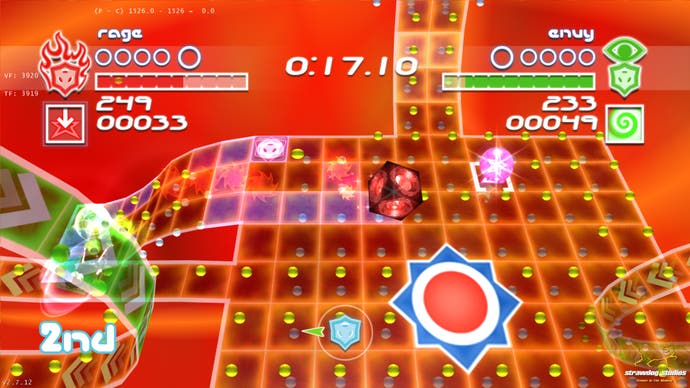Geon: Emotions
Time of the month?
Somebody has been working hard to make Geon: Emotions sound more enigmatic than it really is. Not content with letting the game's specifics hide within the vagaries of the abstract futuristic sports genre, the developer/ publisher/ PR agency has sought to further befuddle consumers with talk of gameplay based around 'playing to emotional strengths', 'using feelings to your advantage' and other such imprecise spin.
But spend ten minutes with the game and the shroud of mystery quickly slips off to reveal something quite conventional underneath. Indeed, the core mechanics are almost pedestrian, though the exciting, bright and good-looking visuals desperately attempt to communicate otherwise.
Contrary to first impressions, Geon is not a puzzle game but, principally, a racing game. You control a cube that must be rolled around a simple grid-like environment while gobbling up Pac-Man-esque pellets. Once you've collected a set amount of pellets you hurry towards a goal where you deposit them and score a token. You then head back out into the level to collect more of the remaining pellets until you have enough to buy another token, and so on. It's a two-player game and the race is to see who can score five tokens first.
To make matters more interesting, the designers pull a number of tricks - the primary conceit being that your rival is playing on the opposite side of the grid you play on. As such, you can see their pellets through the semi-transparent floor while also being able to track their movements and progression. Additionally, the goal where you must deposit your pellets is situated at the centre of the opposite side of the board, deep within your opponent's territory. So, once you have collected the required number of pellets you race to the edge of the grid, flip it over with the X button, and roll across their side of the board to reach the goal and collect the token.

This set-up establishes an interesting rhythm of play where players are separate from one another one moment, and then invasively together the next - a good idea that elevates what is otherwise an acutely simple one.
Thrown into this mix are power-ups and pick-ups that allow you to interfere with your competitor's side of the board in various ways. The power-ups appear at random around the board during play, and the abilities that they grant your cube are dictated by the 'emotion' you picked before the match.
Choosing an 'emotion' is, in the same way as picking a character for a beat 'em up, simply a way of defining what abilities will be open to you during play. For example, 'Envy' has a vortex pick-up, which enables you to suck in pellets from a around your vicinity as your cube moves across the grid; 'Passion' grants a powerslide pick-up, which allows you to slide off in a straight line at high speed; 'Bliss' creates a trail behind the cube, which if the other player touches causes him to lose pellets, while 'Fear' provides 'obscure', which hides what you are doing from the opponent. The power-ups are of varying use but it's disappointing how little the choice of different emotions seems to affects the flow of play - especially when considering their prominence in the promotion of the game.
The speed of your cube is painfully slow at first, especially for Live Arcade players used to the speed of clear rival Pac-Man Championship Edition. However, when you pick up certain power-ups you gain a speed increase that brings your control more in pace with that of the frantic thumping music and visuals. Herein lies a dilemma to the player: deploy the power-up and lose the speed boost, or hang on to it. It's a cute idea but setting the default cube speed far higher than it currently is would have injected the game with something more of the exhilarating pace it so obviously requires.

Because levels are area based, rather than using Pac-Man's wraparound maze/ alley-based level design, the feeling that your cube is too slow is exacerbated. Clearing a line of pellets only to have to awkwardly manoeuvre the cube around and back on itself to continue clearing the area is clunky and awkward. On this score again, the game loses to Pac-Man's more elegant and streamlined approach which encourages directed, fast-flowing play compared to the more staccato rhythm of controlling Geon.
There are forty maps in total playable across in a variety of modes against both AI and human competitors. The level design gets more interesting as the game progresses with moving platforms, half-pipes, see-saws and helixes introduced to later stages to bring some diversity into play. A set of bonus mini-games add variety to the basic rules but, even with this slew of game options, it never feels as though there is much real weight to the package.
While Pac-Man: Chamionship Edition and Geometry Wars have ably demonstrated that very simple ideas can be attractive, compulsive and addictive to a modern audience on the XBLA platform, Geon fails to match these popular rivals - despite boasting more content than each combined. There is only one reason for that: ultimately, the core process of gathering up pellets and delivering them to the goal simply isn't as fun as it should be. For a game built upon this crucial cornerstone, no matter how many ideas are added on top of it, the whole construction remains unstable and, soon enough, un-enjoyable.

